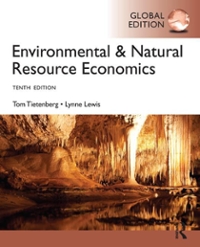Question
1. A firm that can dump its unfiltered waste products into our waterways will be: a. Paying the full cost of production b. Paying more
1. A firm that can dump its unfiltered waste products into our waterways will be:
a. Paying the full cost of production
b. Paying more that the full cost of production
c. Enabled to sell its product at a lower price than if it filtered its wastes.
d. Doing none of the above.
2. Which of the following is a barrier to entry?
a. High profits made by existing firms in the market.
b. Low capital and advertising costs.
c. Diseconomies of scale.
d. The need for large distribution networks to enter the market.
3. The case for deregulation rests on the argument that:
a. Government imperfections are worse that the market imperfections they were designed to cure.
b. Public goods are best provided by laissez faire.
c. Economics of scale are better achieved with the invisible hand.
4. A firm with market power uses its market power to:
a. Maintain lower costs of production than would prevail in a competitive market.
b. Maintain higher prices than would prevail in a competitive market.
c. Maintain lower prices than would prevail in a competitive market.
5. The costs associated with the employment of workers by the federal government regulatory agencies refers to which of the following kinds of regulatory costs?
a. Efficiency costs
b. Capital costs
c. Compliance costs
d. Administrative costs
6. The human and capital resources expended by firms to learn about government regulations, to change production behavior, and to file reports with regulatory authorities refers to which of the following kinds of regulatory costs?
a. Administrative
b. Compliance
c. Efficiency
d. Technological
7. The type of regulatory cost which may impede new technology, new marketing initiatives, or improved production processes is:
a. Compliance cost of regulation
b. Efficiency cost of regulation
c. Administrative cost of regulation
d. Budgetary cost of regulation
8. Before deregulation long-distance telephone service could be characterized as:
a. Perfect competition
b. Monopolistic competition
c. Oligopoly
d. A monopoly
9. Social costs are:
a. The full resource costs of an economic activity
b. Usually less than private costs.
c. The costs of an economic activity borne by the producer.
d. All of the above.
10. Externalities are:
a. Domestic economic impacts of foreign events
b. The difference between social and private costs (benefits)
c. Outside costs that producers absorb
d. Effects of government on the private sector
11. Private costs are:
a. Costs borne by a third party as a result of the polluting activities of producers
b. Externalities
c. The cost of an economic activity borne directly by the immediate producer or consumer
d. Typically greater than social costs.
12. Which of the following is not generally a characteristic of agriculture?
a. Ease of entry and exit.
b. Market power
c. Homogeneous products
d. Artificial restraints on prices
13. Farm price support programs most often take the form of:
a. Price floors which cause shortages
b. Price floors which cause surpluses
c. Price ceilings which cause shortages
d. Price ceilings which cause surpluses
14. The "hiring rule" is that you can hire additional labor until:
a. Profit = zero
b. MRP= WAGE (MIC)
c. ATC= MC
d. The shutdown point is reached.
15. Which of the following is a form of government intervention that is designed to correct market imperfections?
a. Dynamic inefficiency.
b. Regulation
c. Economies of scale
16. A natural monopoly:
a. Does not provide any basis for government regulations.
b. Is not a source of market failure
c. Arises from the existence of substantial economies of scale.
Step by Step Solution
There are 3 Steps involved in it
Step: 1

Get Instant Access to Expert-Tailored Solutions
See step-by-step solutions with expert insights and AI powered tools for academic success
Step: 2

Step: 3

Ace Your Homework with AI
Get the answers you need in no time with our AI-driven, step-by-step assistance
Get Started


